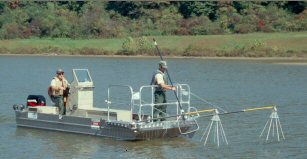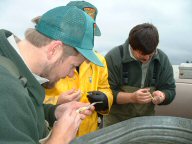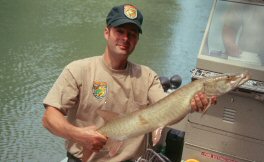

Fishing For FactsBy Chiris O'Bara , Zack Brown, Scott Morrison and Kevin Yokum
Fortunately, Division of Natural Resources fisheries biologists are currently conducting field and laboratory activities to provide answers to these and many other questions about our state's valuable fishery resources. From our numerous warmwater streams, to our small impoundments and large reservoirs, and beyond to our large commercially navigable rivers, biologists are conducting fisheries surveys to gain a better understanding of many gamefish species. DNR biologists have organized survey projects on our lakes and rivers to focus on three basic areas: 1) population structure and angler harvest, 2) movement within and between rivers and streams, and 3) the effectiveness of stocking. These studies are funded from monies acquired through the federal Sport Fish Restoration Act, as well as West Virginia hunting and fishing licenses. The Sport Fish Restoration Act program is unique in that excise taxes on sport fishing equipment and motorboat fuel provides matching funds for states to conduct surveys, raise and stock fish, develop boat ramps and other fishing-related facilities, and conduct aquatic education. These projects provide greater fishing opportunities to West Virginians.
POPULATION STRUCTURE and ANGLER HARVESTFish are collected in the spring from several locations within each water body using an electrofishing boat. The fish are weighed and measured, and a small number are sacrificed to remove the inner ear bones, or otoliths . Rings are formed on the otoliths just like the annual rings on a tree. Biologists can then determine the age of the fish at a given length. Using this data, biologists can also calculate the survival of a specific species in the same manner that life insurance companies determine the longevity of a human population. Fish survival is a factor of habitat, food availability, winter conditions, water fluctuations and angler harvest. With this data, biologists can determine which factors may limit fish growth and abundance, and what could be done to improve fish populations. Another important aspect of their studies is to determine what percent of the fish population is being caught by anglers. The number of fish caught and/or kept by anglers can change the size and age structure of a fish population. Largemouth and smallmouth bass, hybrid striped bass, sauger , walleye and channel catfish are being tagged with numbered colored tags. Anglers are encouraged to report tagged fish to the DNR Parkersburg Office (304-420-4550). A hat will be given as a reward to every angler who catches a tagged fish and reports the tag number and location caught. FISH MOVEMENTTag returns also provide the DNR with information on fish movement, another major focus area. Understanding fish movement is especially important when considering new regulations for rivers, or for determining the influence of habitat and dams on fish populations. Major efforts will be made to tag smallmouth bass on the South Branch of the Potomac, Greenbrier and New rivers, and sauger , walleye and hybrid striped bass on the Ohio, Kanawha and Monongahela rivers.
When recaptured by biologists or anglers, a wand, similar to the one at the checkout counter of your local store, is used to identify the fish's size and location when first tagged. The fish are then weighed and measured for length, providing valuable information on growth and movement. Muskies , Inc. has also purchased these wands. Club members are aiding biologists in recovering these tagged muskies . STOCKINGThe last area of focus is a five-year evaluation of musky and channel catfish stocking efficiency. Prior to stocking, biologists inject a durable, colored, liquid plastic marker into the fish's fin to allow biologists to identify that fish in the future. Muskellunge are stocked into Woodrum Lake and the Buckhannon River, and follow-up surveys by DNR biologists and Muskies , Inc. anglers will determine the success of these introductions . Marked channel catfish have been introduced into Conaway Run, and Krodel and Mountwood lakes. Follow-up surveys and information from anglers will provide a measure of stocking success. FUTURE BENEFITSWhat does this mean to West Virginia anglers? Study results that examine age and growth, survival, angler harvest and fish movement may be used to refine our current fishing regulations. Biologists may also use the results to determine the best size of channel catfish to stock or the best time to stock muskies . Information on the size, age, longevity and growth of different species will be provided to anglers so they can gain a better understanding of West Virginia's fisheries resources. The overall goal of our fisheries survey projects is to provide greater angling opportunities and satisfaction for Mountain State anglers. So, back to those familiar questions: How old is that 12-inch largemouth bass? And, how far does a hybrid striped bass move? Stay tuned for study results and what they mean for anglers in future issues of West Virginia Wildlife magazine. Chris O'Bara , Kevin Yokum , Scott Morrison and Zack Brown are DNR fisheries biologists. |
 How old is that 12-inch largemouth bass you caught from Stonewall Jackson Lake? How far does a hybrid striped bass move on the Ohio River? When will you change that regulation on the South Branch River? These are questions fisheries biologists are often asked by curious anglers. As we all know, questions are much easier to ask than to answer.
How old is that 12-inch largemouth bass you caught from Stonewall Jackson Lake? How far does a hybrid striped bass move on the Ohio River? When will you change that regulation on the South Branch River? These are questions fisheries biologists are often asked by curious anglers. As we all know, questions are much easier to ask than to answer.  To answer those original questions, as well as others, biologists have started a five-year study on largemouth bass on selected reservoirs, including Stonewall Jackson, Tygart and Beech Fork; a three-year study on small impoundments including Elk Fork, Plum Orchard and Sleepy Creek; and a study on smallmouth bass in the South Branch of the Potomac, Greenbrier and New rivers. In addition, studies are being conducted on walleye, sauger , saugeye , and largemouth and smallmouth bass on the Ohio, Kanawha and Monongahela rivers, and muskies in the Buckhannon River and Middle Island Creek.
To answer those original questions, as well as others, biologists have started a five-year study on largemouth bass on selected reservoirs, including Stonewall Jackson, Tygart and Beech Fork; a three-year study on small impoundments including Elk Fork, Plum Orchard and Sleepy Creek; and a study on smallmouth bass in the South Branch of the Potomac, Greenbrier and New rivers. In addition, studies are being conducted on walleye, sauger , saugeye , and largemouth and smallmouth bass on the Ohio, Kanawha and Monongahela rivers, and muskies in the Buckhannon River and Middle Island Creek.  DNR biologists have also initiated a study on muskellunge on the Buckhannon River and Middle Island Creek in cooperation with the West Virginia Chapter of Muskies , Inc . Muskellunge are collected using an electrofishing boat. Biologists then insert a passive integrated transponder, or PIT tag, under the skin near the head. This ¼-inch tag consists of an electromagnetic coil, tuning capacitor and microchip, which transmits a low-frequency radio signal which reveals a unique ID code.
DNR biologists have also initiated a study on muskellunge on the Buckhannon River and Middle Island Creek in cooperation with the West Virginia Chapter of Muskies , Inc . Muskellunge are collected using an electrofishing boat. Biologists then insert a passive integrated transponder, or PIT tag, under the skin near the head. This ¼-inch tag consists of an electromagnetic coil, tuning capacitor and microchip, which transmits a low-frequency radio signal which reveals a unique ID code.